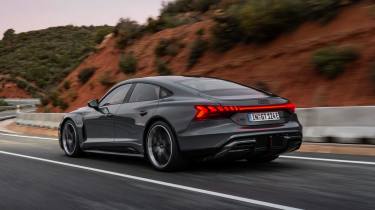The new Audi RS e-tron GT Performance has more power than a McLaren P1
Audi’s new RS e-tron GT Performance is its most powerful road car ever, packing 912bhp and an updated chassis beneath its familiar design
The EV power race is showing no signs of slowing down, and Audi has joined the party by updating its four-door electric supersaloon, the e-tron GT. Following in the wake of the newly facelifted and closely related Porsche Taycan, the e-tron GT arrives with a raft of improvements to its powertrain, chassis and design to allow it to go further and faster than before. Or in the case of the RS e-tron GT, much, much faster.
Audi’s flagship electric car has seen a boost from 637bhp to a staggering 844bhp, or 912bhp if you order it in Performance spec. That makes it the most powerful production car in the company’s history, and a 0-62mph time of 2.5sec puts it within touching distance of a Bugatti Chiron. The non-Performance RS completes the same sprint in 2.8sec, and even the S e-tron GT generates 670bhp – good for a time of 3.4sec. The base car reaches a 152mph top speed, with RS models maxing out at 155mph.
The e-tron GT’s extra power comes courtesy of a dual-motor powertrain that derives tech from Audi’s newly-developed PPE platform, with a more powerful unit driving the rear axle. The RS gets unique electronics at the front axle and a bespoke pulse inverter, as well as an overboost function to release an extra 94bhp for ten seconds. As well as being faster, the e-tron GT gets revised powertrain components to eke out more miles from a charge.
The new rear motor is around 10kg lighter than before, the battery pack weighs less despite an increase in capacity to 97kWh and the cell chemistry has been optimised to deliver up to 375 miles of range. Charging is quicker too thanks to improved thermal management and preconditioning systems, raising the peak rate from 270kW to 320. A 10-80 per cent top up takes just 18 minutes as a result, and 174 miles of range can be added in just 10 minutes at a suitable charging station.
To harness the powertrain’s extra performance, the e-tron GT comes with two-chamber air suspension as standard, with dual-valve dampers offering a better blend of comfort and control than before. Top-spec Vorsprung models go a step further with a fully active setup, similar to what you’ll find on the new Porsche Taycan. This keeps the body flat under load to spread forces evenly across all four wheels, counteracting pitch and roll. The active suspension also serves to improve ride quality, allowing each wheel to independently react to and absorb bumps to keep the body stable.
Quicker gearing for the steering rack and rear-axle steering have been installed to give the e-tron GT more agility, with newly-developed brakes (with tungsten carbide-coated discs on the RS) helping it to stop more quickly. The RS e-tron GT Performance gets ceramic discs with ten-piston calipers as standard.
While the e-tron GT has taken a huge technical leap forward, it looks very much the same as before – not that we’re complaining. Subtle changes to the front fascia and rear valance have refined the space-age coupe-like design, with the RS gaining a more aggressive front bumper and diffuser. Optional carbon exterior elements set the flagship apart too, along with forged and milled 21-inch alloys.
Inside, there’s the option for wood trim or more carbon, new seats and a new steering wheel with a flat top and bottom (the RS gets additional controls on the wheel and an optional red 12 o’clock stripe). Audi’s latest MMi infotainment system also features, displaying more detailed battery and charging data on the e-tron GT’s ‘virtual cockpit’ dash.
If some of the e-tron GT’s upgrades sound familiar, that’s because many of them are shared with the latest Porsche Taycan, which shares its J1 platform with the Audi. We'll find out how the two cars match-up on price in the UK when e-tron GT prices are released at the beginning of August.










